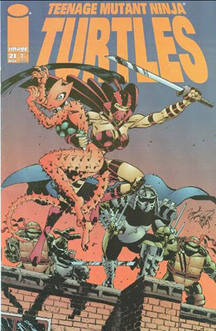Writer Gary Carlson and penciler Frank Fosco (who inks the final issue, showing us what his art was supposed to look like all along) end “Teenage Mutant Ninja Turtles” Volume 3 with their best issues yet. Carlson wraps up a lot of threads, but because of the fairly sudden cancellation, some questions are unanswered.
He delivers some great final-page cliffhangers in this batch, from Issue 17’s revelation that Komodo, not Leatherhead, is prowling the sewers, to Issue 21’s surprise that Lady Shredder is NOT Pimiko. But who is the Lady Shredder? Without a doubt, that lingering cliffhanger is the most frustrating part of the end of the Image series.
Back to Mirage roots
In this batch of issues, Carlson – whose one major flaw is that the Turtles’ emotions are sometimes sacrificed to his fast-paced narratives — gets closer than ever to the Mirage “TMNT” roots. In Issue 17, Leonardo narrates (a la Volume 1, Issue 1) his hunt for the sewer killer, and in Issue 22, Raph (in Shredder garb) narrates his fight with Pimiko, who emerges as the best of Carlson’s original “TMNT” creations.

“Teenage Mutant Ninja Turtles” Vol. 3 Issues 17-23 (1998-99)
Writer: Gary Carlson
Pencils: Frank Fosco
Inks: Erik Larsen, Chance Wolf, Andrew Pepoy, Mark Heike
For long stretches of the Mirage run, “TMNT” begged for a decent villain. Pimiko is not only intriguing for being the Shredder’s daughter, but she also has a cool fighting accessory – the long braid with claws at the end.
While Mirage-style fight scenes never interested Carlson and Fosco much, they deliver a great extended battle to close out this series – first with Raph and Pimiko squaring off, and then with the two of them teaming up to fight the Foot Clan, which turns on Raph and sides with the visiting Japanese Foot leaders.
It was never entirely clear what Raph planned to do with the Foot once he controlled them; and in the end, we learned that the idea of the Foot becoming good guys was a long shot. But one of the volume’s best scenes, in Issue 18, allows readers to relate to both sides of an argument between Raph and Splinter:
Splinter: “Perhaps seeing you in the armor of my enemy makes me realize that I failed not only as a father, but also as a teacher, Raphael. Please have the courtesy to remove that mask in my house.”
Raphael: “The armor isn’t evil, master. Only the man who wore it was. And he is dead! I can use it to accomplish good things!”
A classic feel
Issue 23 gives a nod to the first Image issue by having the Turtles celebrate their 19th birthday (they celebrated their 18th in Issue 1), but more impressively, it has a classic feel due to the fight against the Foot Clan and Shredder (or Lady Shredder, as it were).
Also in this final batch, we get a healthy dose of Leatherhead, one Utrom (Leatherhead’s only pal, Dr. X), and Triceratons. The Triceratons’ random appearance via Leatherhead’s transmat is very similar to their opportunistic Earth invasions in Volumes 1 and 2, but it works here as sort of a continuation of a running joke.

While I complained about too many Image Universe characters in the middle books of this volume, in the end, we’re left with the best of the bunch — Mike’s spikey alien girlfriend Sara (a.k.a. Horridus). Although she is technically a “Savage Dragon” character, she is beautifully integrated into “TMNT” thanks to her cute love story with Mikey.
They meet in “Savage Dragon” No. 22 and are still going strong as the Image “TMNT” series ends. And so, for that matter, is Mike’s writing career: He gets his first novel published!
Still hiding
One contradiction in the Image volume that feels a bit unresolved is that “freaks” are celebrities in Image’s Midway City and Chicago, but the Turtles still have to hide “from those who would be our allies” (as they say in Volume 1, Issue 1) in New York.
I was pleasantly surprised to discover on my re-reading of Issue 20 that a 20-year-old me wrote a letter where I contended that the Turtles should remain in hiding, rather than developing social lives, as that was at the core of their characters. Carlson smartly responded:
“While the Image universe is a little more tolerant of ‘freaks’ than the real world, I still view the Turtles as outsiders, John, especially in New York, where they will continue to keep a low profile. They’ve made plenty of enemies over the years and it’s always a good idea for them to keep a low profile.”
Perhaps Carlson would’ve eventually brought the Turtles, Leatherhead, the Triceratons and the Utroms out of hiding – like Peter Laird would go on to do in Volume 4, and similar to the mainstreaming of vampires and slayers in the “Buffy” comic books.
But I think Carlson achieved a nice Image Universe/Mirage Universe balance, and considering that editor Erik Larsen asked Carlson to continue his Deathwatch arc in “TMNT,” he did it about as well as he could’ve.
Vol. 3 could’ve been great
While we’ll never know the full extent of how great Volume 3 could’ve been if it had gotten, say, 62 issues like Volume 1 did, Carlson does drop a couple hints in the letters pages of the final issues about stories he had planned. He intended to explore the regeneration of Leo’s hand – eaten by Komodo in Issue 18 – and Don’s turmoil about living in his cyborg body. Carlson writes in the Issue 22 letters:
“My feeling was always that Donny was the one that came up short. Exploring his armor and his feelings about it was always ‘the next storyline’ I wanted to do, and now I won’t get the opportunity to explore it all. Sorry, Don.”
I’m sorry, too, that Volume 3 didn’t get to continue. Controversial though it may be (and even I’m uncomfortable about Don’s cyborg status, although I was neutral toward Leo losing a hand and Splinter becoming a bat, and I loved the Raph-as-Shredder thing and Mike’s writing career), I honestly think it’s the most consistently strong of the first three “TMNT” volumes, and that Carlson ranks among the elite writers to work on the property.

